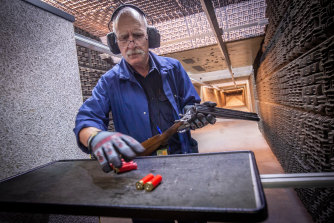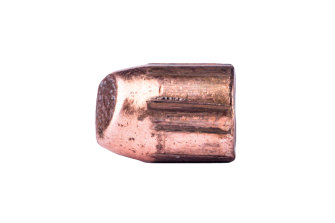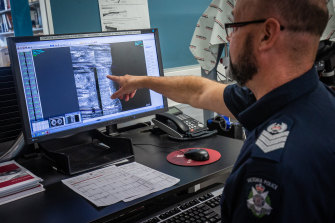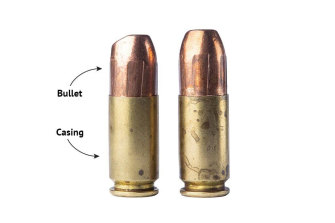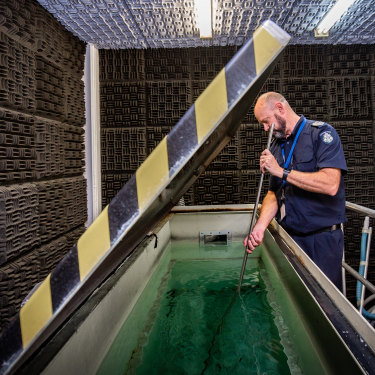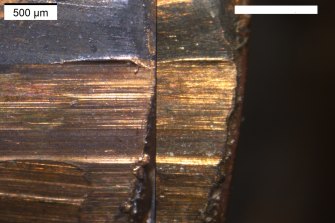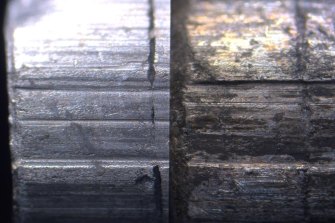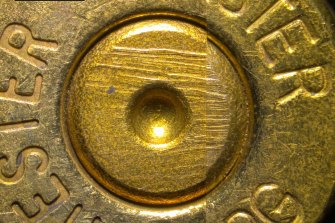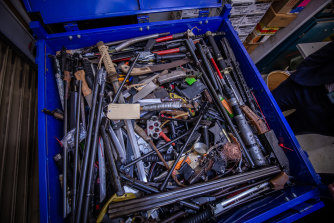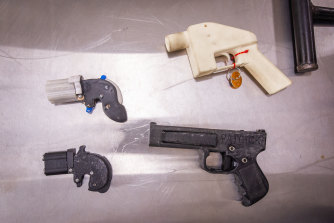Take a bullet from a crime scene and put it under a microscope. What do you get? One of the keys to solving a crime.
Engraved on every bullet is a story about the gun that fired it.
In a bunker under a police forensic facility, a ballistics officer aims a sawn-off shotgun down a firing range. It’s one of the hundreds of sawn-offs seized or handed over to police every year.
“Firing!” yells Leading Senior Constable Steve Batten. He squeezes the trigger and 50 metal pellets exit the barrel, spraying outwards and burying themselves in a pile of sand. The shockwave is intense. The scent of gunpowder fills the room. Batten holds up a blackened shell.
Leading Senior Constable Steve Batten reaches for a shotgun shell at the police firing range.Credit:Scott McNaughton
There are about 3.5 million registered firearms in Australia and about a quarter of a million illicit ones. Sawn-off shotguns are now criminals’ weapons of choice in drive-by shootings. In small towns, crooks cruise around looking for trucks parked in driveways that bear the bumper stickers of gun makers like Winchester or Remington – revealing the likely contents of the car owner’s gun safe.
When crooks come back to crack the safe, if they find a shotgun they’ll often cut down the barrel and handle, both illegal modifications. In this way, a hunting tool becomes an urban weapon that can be tucked into a belt and quickly withdrawn.
But the shotgun shell cooling in Batten’s hand could be a crook’s undoing. If police match it to a shell from a crime scene, they’ll know that the shotgun Batten just fired is the very gun used in that crime.
This year in Victoria there have been seven fatal shootings and 11 non-fatal. In 32 homicide investigations for the year, those involving firearms account for less than 22 per cent. In NSW this year, of a total of 60 murders just up to March, 10 victims, or about 17 per cent of killings, involved a firearm.
As police warn that both Melbourne and Sydney are on the edge of more vicious gangland wars, it makes the work of ballistics units even more urgent as they try to track down killers and foil more shootings on the streets.
But how do police do it? How much can a bullet tell you?
Shotgun shells and a single 9mm bullet of the kind the ballistics team collect from scenes and examine.Credit:Eddie Jim
Who are ballistics teams?
If a bullet (or, less often, a gun) is found at a crime scene, it’s dusted for prints and swabbed for DNA before going to the police ballistics team. There’s one in every state and territory in Australia, with a database hub in NSW. Murders, high-profile shootings, drive-bys – the cases that attract attention and heavy sentencing – go through ballistics.
The training to become a certified expert takes about eight years. It’s a massive commitment to join the team and dedicate almost a decade to learning how to match guns. “It’s a pretty rigorous program, but once all that’s completed, and they’ve got past it – and they don’t always [complete the course] – then they can be certified as an expert,” says Senior Sergeant Steve Farrar of the Victoria Police Forensic Services Centre.
Scrutinising ballistics ensures an investigation is travelling in the right direction, Farrar adds. It’s about making sure the right person is locked up “so we just can’t afford to ever get it wrong – doing so could cause the investigation to go down the wrong path, potentially resulting in injustice”.
“We sit on the fence,” he says. “We’re employed by Victoria Police, but we’re really independent. Our customer, if you like, really is the court.”
Judges tell juries that they are free to interpret expert forensic evidence, and it shouldn’t simply be accepted as true.
The ballistics team’s first job is to help investigators figure out what make and model of gun likely fired a bullet recovered at a scene.
A single bullet marked with striae after being discharged from a handgun.Credit:Simon Schluter
From a bullet, such as the one above, an examiner will be able to determine the calibre of a gun – the measure of the internal diameter of the barrel. But one size of bullet can fit into a range of handguns and one kind of shotgun shell can fit into a range of shotguns. It’s up to the ballistics team to narrow down the possibilities. When first presented with the bullet, “we can’t say, ‘it’s this gun or that specific gun’,” Farrar explains, “but we can say, ‘You’re looking for one of these three or four firearms, in terms of make and model’.”
Of course, when someone’s been shot or a gun’s been fired, police try to recover the exact firearm. But that can be difficult, and police encounter a multitude of firearms while conducting searches. Still, when a shooting has just happened, there’s a strong incentive to move quickly to identify a firearm – suspects can leave town or hop on a plane to avoid detectives. In a recent double shooting, Farrar says, a firearm was seized at 12.30pm and arrived at the ballistics unit by about 2.50pm. “The comparison had been completed and verified by 6.45pm that night.”
Senior Sergeant Steve Farrar at Victoria Police Forensic Services Centre.Credit:Scott McNaughton
What are police looking for on a bullet?
Farrar peers at images on a computer screen of two bullets side by side and points out microscopic indentations. Police call these indentations “striae”. Farrar’s team will capture the striae profile and then potentially link it with a gun.
Capturing the striae is a complex and specialised process. They are created when a pistol or a rifle is fired and the bullet rotates out of the barrel (spin gives bullets more speed and accuracy). What makes it rotate are grooves inside the barrel called rifling. As the bullet is propelled through the barrel, the grooves exert a rotational force on the metal surface that’s so strong it leaves marks. Under a microscope, these striae are all distinctive and different – and they will correspond to the grooves inside the barrel of the gun that fired the bullet.
Credit:
Why would these grooves be different from one gun to another? The tools that cut grooves into gun barrels wear and get chipped over time, says Farrar. As they’re used to make one gun and then another “it leaves a slightly different set of microscopic imperfections resulting in discernible differences between the bullets fired in these consecutively manufactured barrels”.
When police have a gun they suspect was involved in a crime, to analyse a bullet from it they’ll fire it themselves, in either a firing range (if it’s a shotgun, where the pellets are absorbed by sand) or, if it’s a pistol or rifle, into a large tub of water called a tank. The tank looks like an oversized sensory deprivation tank of the kind favoured by wellness centres, only it has a small opening at one end. A ballistics officer will rest the barrel in the small hole and squeeze the trigger. The water takes the impact of the bullet but doesn’t damage it, so for forensic purposes it’s as close to pristine as the team gets.
Senior Sergeant Steve Farrar with the ballistic tank at Victoria Police Forensic Services Centre.Credit:Scott McNaughton
The just-fired bullet has the unique striae from the gun that police reckon could have fired the suspect bullet. “We fire the gun three times,” says Farrar. “What are the common areas of ‘agreement’ between those three test-fired ones? Once we’ve established them in our head, we’ll then bring in the suspect bullet and look for those same commonalities,” he says.
So police now have two images to compare.
Here’s what they look like under the microscope.
A striae comparison image of a 9mm round.Credit:Victoria Police
On the left, we see the striae left by the rifling inside the chamber of a gun, and on the right we see those same striae in the same place – but on a different bullet fired from what police suspect to be the same gun. They’ve likely received that gun from detectives investigating the case and they’ve fired bullets out of it themselves, including at the firing range where Batten is holding the blackened shell.
Two sets of striae on a 9mm bullet that do not match.Credit:Victoria Police
Here you can see an example of two bullets that examiners determined were not fired by the same gun because the striae are dissimilar: the pattern left by the rifling on the left is different to the pattern on the bullet on the right.
Examiners take a similar approach to matching indentations made by the firing pin on the base of a cartridge. A firing pin strikes the cartridge, detonating the priming compound and igniting the gunpowder that forces the pellets out of the chamber. In these side-by-side images of shotgun cartridges under a microscope, below, you can see the similarities of the two indentations. Again, it’s matching those distinctive indentations that helps ballistics units connect guns to the rounds they discharge.
Below is another example provided by police: the C-shape indentation in the centre, made by an imperfection on the nose of the firing pin, is a similarity that assists examiners match the shells to the gun that fired it.
An imperfect shotgun pin has left a distinctive C-shape marking on the two shells.Credit:Victoria Police
Below is another example. This is a side-by-side comparison of the marks left on the base of two different nine-millimetre rounds by a firing pin. Again, the patterns are similar.
Two images shown side by side by Victoria Police to demonstrate the markings on the shell casings are similar.Credit:Victoria Police
Farrar likens the differences they’re able to detect in fired bullets to a pair of sneakers. When a pair of runners leaves the factory floor, he says, they are superficially similar but contain microscopic differences: the rubber sets slightly differently, bubbles form in different spots. When they’re used, they’re changed again, by the gait of a runner or whether they’re running on gravel or asphalt – the wear is reflected in the shoe’s sole.
The just-fired bullet is analysed by two officers who are unaware of their counterparts’ conclusions. “If we find [unique markings] and we find enough of them to form an opinion in our mind – that that gun fired that bullet to the exclusion of all others – then we can call it a match. If we find there’s no agreement whatsoever, and perhaps the pattern isn’t even the same, we categorically say that the gun did not fire that bullet.”
The team sometimes sends detectives back to the drawing board. “We often deliver, in the eyes of the investigator, bad news. We’ll say, ‘That’s not your gun’ … they think they’re on the right track. It’s our duty to tell them they’re not if they’re not.”
Results are also fed into the Australian Ballistics Information Network, which is connected to databases in other states and houses information collected all over the country. The database hub is in NSW.
The NSW Police force has been investigating a spate of shootings in the past two years – gang violence in south-west Sydney has seen 13 shootings in that period alone. State Crime Command director Detective Chief Superintendent Darren Bennett says the violence is informed by family conflicts and intergroup conflicts – but mostly the desire to control Sydney’s lucrative drug market.
The NSW ballistics team works to examine shooting scenes and identify guns. “After each serious shooting incident, ballistics investigators and other forensic discipline representatives conduct a review with investigators,” a spokesman says.
In Victoria, killer Ashley Mervyn Coulston might never have been connected to a triple murder in Burwood without ballistics analysis. Coulston was picked up by police carrying a silenced .22-calibre sawn-off rifle. It was a ballistics forensic examiner who linked the weapon to the murders in suburban Melbourne of 22-year-olds Kerryn Henstridge and Anne Smerdon, and Peter Dempsey, 27, five weeks earlier.
In June, the firearms unit at Queensland Police linked the firearm used in the killing of John Lazzaro at Rochedale South, in southern Brisbane, in 2012 to an unregistered firearm recovered in Queensland – a Browning 1900 .32-calibre semi-automatic.
On the other hand, in the recent retrial of Jason Roberts in Victoria, the prosecution used ballistic and forensic experts to support its contention there were two gunmen, and Roberts was responsible for shooting police officer Gary Silk. The jury did not accept that contention and acquitted.
Weapons seized or handed in to Victoria Police.Credit:Scott McNaughton
What do they do with guns and bullets afterwards?
The ballistics unit doesn’t just test guns and match bullets, they also destroy them. Beside the tank is the gun press. It bends gun barrels and splinters wood under 50 tonnes of pressure. In 2021, police destroyed 14 crates each holding about 1000 kilograms of weapons.
Police have a variety of weapons handed in, including during gun amnesties, or confiscated from the streets: shotguns, sawn-offs, rifles, knuckle dusters, knives, swords, machetes, tasers, daggers, kitchen knives, nightsticks, bats, batons, rusted hooks, bolt cutters, hand axes and even some more disturbing homemade weapons, all destined to be crushed.
A selection of 3D-printed guns in the possession of Victoria Police.Credit:Scott McNaughton
Police have also seen more 3D-printed guns. One printed pistol seized by police was dubbed “the Songbird” by its creator and carries the name “Patrick” on the side.
Sergeant Andrew Nisbet, another member of the ballistics team, says they haven’t detected an instance where a 3D-printed gun has been used successfully on Victoria’s streets because, at least in Australia, they’re not yet reliable enough as a weapon. Police say when people are firing these weapons they’re disintegrating. “It’s a self-defence weapon … you’re not going to try to murder someone [with it]. It’ll be a drug dealer carrying it for protection.”
In the United States, there have been concerns raised about whether firearms analysis works in connecting a bullet to a gun. One study by the US Defence Department’s Forensic Science Centre indicated that, nationwide, the false positive rate was about one in 66, and could be as high as one in 46. In 2016, the executive office of the US president’s council of advisers on science and technology expressed concerns to the White House that not enough empirical studies had been completed.
The report said many earlier studies into firearms analysis had been “inappropriately designed” to “assess foundational validity and estimate reliability” and underestimated the false positive rate in tying a gun to a bullet. Victoria Police’s chief forensic scientist, Dr Kaye Ballantyne, says large global research studies are being done to provide courts and police with more data and assurance that the discipline of firearm analysis is reliable, accurate and trustworthy. “For example, another recent double-blind test of casework laboratories showed no false positive results across nearly 600 comparisons in both the US and Europe.”
Farrar says while firearm and tool mark examination has been challenged over the years, ongoing research in the field continues to address concerns and advance the discipline: “The courts can be assured of the quality of our evidence through a number of checks and balances that are required to be conducted prior to an examiner giving their evidence at court.”
Forensic crime investigations are a staple of modern TV shows, but this is not particularly glamorous work. The team sees a spectrum of violent, homicidal offending. Gang violence, yes, but sometimes family violence as well. Working in the unit is not for everyone. “Most of our jobs are pretty sad,” says Farrar. “We have a culture of supporting each other. We’re a tight unit, and ideally, we recruit people who have a solid support network.”
If you'd like some expert background on an issue or a news event, drop us a line at [email protected] or [email protected]. Read more explainers here.
Most Viewed in National
Source: Read Full Article
